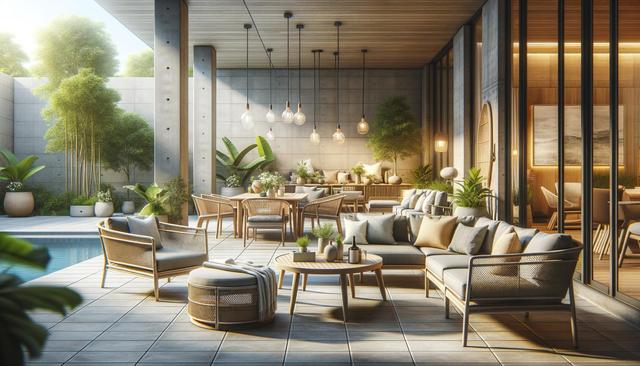Defining Your Outdoor Space
Before selecting patio furniture, it’s essential to define the purpose and layout of your outdoor space. Whether your goal is to entertain guests, create a quiet reading nook, or set up an alfresco dining area, your furniture choices should reflect that intent. Start by measuring your patio and noting its shape, sunlight exposure, and surrounding landscape. These factors will influence the size, material, and placement of your furniture pieces. By clearly outlining what you want to achieve, you can avoid overcrowding and ensure each item fits comfortably within your design vision.
Think in terms of zones, especially if you have a larger patio. For example:
- Dining area with a weather-resistant table and chairs
- Lounge section with cushioned sofas or chaise lounges
- Accent zone with planters, decorative lighting, or a fire pit
By segmenting your patio, you create a more organized and functional outdoor space that caters to various activities throughout the day.
Selecting Materials That Suit Your Climate
Choosing the right materials for your patio furniture goes beyond style—it’s about durability and maintenance. Outdoor furniture is exposed to the elements, so it’s important to pick materials that can withstand your region’s specific climate. If you live in a humid or rainy area, materials like teak, powder-coated aluminum, and synthetic resin are known for their moisture resistance. For sunny and dry climates, UV-resistant fabrics and treated wood are ideal choices to prevent fading and cracking.
Common patio materials include:
- Wicker (synthetic or natural)
- Metal (aluminum or wrought iron)
- Wood (teak, eucalyptus, or acacia)
- Plastic and resin
Each material has its own maintenance requirements, so consider how much upkeep you’re comfortable with. For example, natural wood may require periodic sealing, while aluminum typically needs just a quick wipe-down to stay clean.
Customized Comfort and Style
Customization is key when designing a patio that reflects your personality and lifestyle. Look for modular furniture sets that allow you to rearrange components based on your needs. Investing in high-quality cushions and outdoor fabrics can dramatically enhance comfort while adding visual appeal. Choose colors and designs that match your home’s exterior or your personal aesthetic. Don’t be afraid to mix patterns and textures to create a dynamic, welcoming environment.
Consider adding:
- Removable cushion covers for easy cleaning and seasonal changes
- Outdoor rugs to define spaces and add warmth
- Throw pillows for added comfort and style
These touches not only make your space more inviting but also help it feel like a true extension of your indoor living area.
Functional Additions for Practical Living
While aesthetics matter, functionality ensures you get the most from your patio. Multi-purpose furniture, such as storage benches or coffee tables with hidden compartments, helps keep the area tidy and organized. Shade solutions like umbrellas, pergolas, or retractable awnings can make your patio usable even during hot afternoons or light rain. Lighting also plays a crucial role—solar-powered lanterns, LED string lights, or built-in fixtures can extend the use of your patio into the evening hours.
Other functional enhancements include:
- Weatherproof covers to protect your furniture during off-seasons
- Portable heaters or fire pits for cooler evenings
- Planters or vertical gardens to add greenery and privacy
These elements contribute to year-round usability, making your patio a practical and enjoyable retreat no matter the season.
Personal Touches to Complete the Look
The final step in creating a custom patio haven is adding the personal details that make the space uniquely yours. Artwork suitable for outdoor use, like metal wall hangings or ceramic pieces, can bring character to plain walls or fences. Wind chimes, water features, or ambient music systems can also enhance the sensory experience. Be sure to consider the flow of movement—ensure enough space between furniture pieces for easy navigation and keep high-traffic areas clear.
Personalization ideas include:
- DIY planters or painted furniture for a creative touch
- A bar cart or beverage station for entertaining
- Custom signage with meaningful quotes or family names
These small additions may seem minor, but they play a significant role in making your patio feel like a true sanctuary tailored to your lifestyle and tastes.
Conclusion: Designing a Space That Reflects You
Creating a custom patio is about more than just placing furniture outdoors—it’s about designing a space that mirrors your needs, personality, and daily rhythms. By focusing on layout, material selection, comfort, functionality, and personal touches, your patio can become a seamless extension of your home. Whether you’re hosting friends, enjoying a quiet morning coffee, or simply soaking up some fresh air, a thoughtfully designed patio can offer relaxation, inspiration, and connection to the outdoors. With careful planning and a bit of creativity, your outdoor haven can be both beautiful and practical year-round.




Leave a Reply